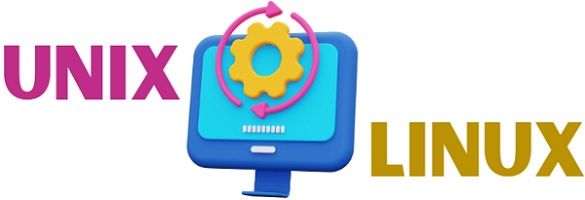 Unix and Linux are the operating systems where Linux was derived from the early version of Unix. Although Linux is a derivative of Unix, they do differ on various points. The significant difference between the Unix and Linus operating systems is that Unix is a closed-source OS, whereas Linux is an open-source OS.
Unix and Linux are the operating systems where Linux was derived from the early version of Unix. Although Linux is a derivative of Unix, they do differ on various points. The significant difference between the Unix and Linus operating systems is that Unix is a closed-source OS, whereas Linux is an open-source OS.
Both Unix and Linux support multi-user, multiplatform, and multitasking. Still, they differ in terms of security, interface, use, error detection, and solution. In this section, we will discuss both of these operating systems in detail. We will also compare them to figure out all possible differences between them.
Content: Unix Vs Linux
Comparison Chart
| Basis for Comparison | Unix | Linux |
|---|---|---|
| Invention | Invented by Dennis Ritchie and Ken Thompson in 1960 at AT & T Bell Labs | Invented by Linus Torvalds at the University of Helsinki in 1991 |
| System Type | Unix is a complete operating system | Linux is just a kernel |
| Licensed | Unix is a licensed OS | Linux is an open-source OS |
| Interface | Primarily it used CLI (Command Line Interface) but later adopted Graphical User Interface (GUI) | Primarily uses GUI (Graphical User Interface) with the option of CLI (Command Line Interface) |
| Shell | Bourne Shell | BASH (Bourne Again Shell) |
| Security | Secure | Comparatively more secure |
| Use | Workstations, internet servers and PCs | PCs, Smartphones, Tablets, mainframes, supercomputers and so on |
| Error detection and solution | As it is a closed-source system, the solution has to be provided by the owner, which takes some time. | Being a community-driven OS, developers worldwide assist in resolving the issue by providing fast solutions. |
| Example | IBM AIX, HP-UX and Sun Solaris | Ubuntu, Redhat, Fedora, etc. |
What is Unix?
Dennis Ritchie and Ken Thompson invented the Unix operating system in the 1960s at AT & T Bell Labs. Later the university of California at Berkeley (UCB) also contributed to the development of Unix. The researchers at UCB filled the gaps in the Unix system of AT & T and released their own version of Unix, which they referred to as BSD-Unix (Berkeley Software Distribution) in 1978.

The continuous evolution of Unix even drew the attention of DARPA (Defense Advanced Research Projects Agency). DARPA was especially interested in developing and integrating the TCP/IP network protocol suite with the Unix system. So, DARPA started funding for the further development of Unix, which helped UCB to draw various versions of BSD. UCB even introduced a Virtual Memory system (VMS), Fast File Systems (FFS), socket facility, large file names, reliable signal implementation, and TCP/IP.
An earlier version of BSD was free and open-source software, and the license allows the use of the operating system for any commercial purpose. During this duration, other computer vendors also came up with their own version of Unix.
- Sun Microsystems – Solaris
- Digital Equipment Corporation (DEC) – Ultrix or Digital Unix
- Microsoft – XENIX
With these evolving variants of Unix, there emerges a need for standardization of the Unix system. So, IEEE came up with a set of rules that must be followed while designing the Unix system. We refer to these rules as POSIX (Portable Operating System Unix).
Even AT & T has announced their own standard that we refer to as UI (Unix International).
Salient Features of the Unix
- Unix is a multitasking operating system. So, it allows concurrent execution of two or more processes simultaneously.
- It is a multi-user operating system. Thus, it allows multiple users to log in simultaneously.
- The Unix OS is highly portable compared to other operating systems, as we can easily port it onto different hardware. The reason behind this is that the Unix OS is written in C programming language, which is highly portable.
- As Unix is a multi-user OS, it offers protection to one user’s data from another. To achieve security, it offers users to create different login credentials.
- Unix operating system enables computers to interconnect themselves and to the Internet. Thus, it is capable of networking.
- The Unix operating system treats everything, such as memory, and I/O devices, as files. Thus, there is a large number of files in the Unix system. To maintain these files, Unix has a well-organized file and directory system.
Limitation of Unix
- The performance of Unix versions differs on different machines, so it needs more consistency.
- The shell interface can be risky, as an incorrect command may destroy files.
- The user interface could be more friendly.
- Sometimes, it becomes difficult to get drivers for some specific software.
What is Linux?
Linus Torvalds, a Finnish-American software engineer, developed the Linux kernel at the university of Helsinki in 1991. He developed the kernel of Linux with the help of a loosely-knit team of programmers connected worldwide over the Internet. The developed kernel is just a clone of the Unix operating system.

The Linux kernel is available in the form of source code over the Internet free of cost. Like, Windows and Unix, you don’t require a license to use the Linux operating system. You can make changes to this source code to suit your requirement. The modified source code can even be distributed further but in the form of source code only.
Earlier, the users used to build several programs, frameworks and utilities around the Linux kernel. But nowadays, the organization offers the precompiled kernel with programs, framework, and utilities on a common media.
The organizations even provide step-by-step installation assistance. RedHat, SUSE, Caldera, Debian, Mandrake, and Slackware are computer vendors popular for distributing Linux systems.
Salient Features of Linux
- Linux is an open-source operating system.
- Linux is flexible and portable as it has most of the coding done in C programming language.
- Like Unix, Linux also supports multi-user, multiplatform and multitasking.
- Linux operates fast and can manage different resources effectively. The reason behind the increased speed is its low memory requirement.
- Linux offers a user-friendly graphical user interface, making it easy to use.
- Linux provides highly robust and capable programming environments to its users.
- Computers with Linux OS are capable of interconnecting themselves and the Internet.
Limitations of Linux
- Some hardware drivers are hardly available, so code patches are applied to support these drivers.
- The learning curve of Linux is steep, and you require some time to learn the operating of Linux.
- Linux has software compatibility issues. Software like Photoshop and MS office is not compatible with Linux operating systems.
- Linux even does not provide support for games. So fewer games are developed for Linux OS.
Key Differences Between Unix and Linux
- Dennis Ritchie and Ken Thompson invented Unix OS at AT & T Bell Labs in the 1960s. However, Linus Torvalds invented Linux at the University of Helsinki in 1991.
- If we talk of Unix, it was developed as a complete operating system. On the other hand, Linux was introduced just as a Kernel of OS.
- Unix is a Licensed operating system, whereas Linux is a free, open-source OS.
- In its early stages, the users of Unix had to use a command line interface which was quite difficult; later, the Unix system adopted a graphical user interface which was quite easier. On the contrary, the Linux system uses a Graphical user interface with the option of a command line interface.
- We know that the user can not directly interact with the kernel. Instead, it interacts with the shell. Shell is a command interpreter that interprets the user command and conveys it to the kernel for execution. The default shell available for Unix is Bourne Shell. However, the default shell available for Linux is the Bourne Again shell (BASH).
- Linux is comparatively more secure than Unix.
- We use Unix OS for a workstation, internet servers and PCs. On the contrary, we use Linux for smartphones, tablets, mainframes, supercomputers, etc.
- Being a closed-source system, it becomes difficult to identify and resolve the errors. However, identifying and resolving errors in the Linux operating system is quite easy.
- Examples of IBM AIX, HP-UX and Sun Solaris. On the other hand, Ubuntu, Redhat, Fedora, etc.
Conclusion
So, this is all about Unix and Linux and their differences. With its features, the Linux operating system is gaining more popularity over Unix.
Leave a Reply